Running a business in Alaska comes with its own set of challenges—and opportunities. Whether you’re located in Anchorage, Fairbanks, or a more remote town, your online presence needs to speak directly to your local audience while competing in a global digital landscape. That’s where Alaska web design makes all the difference.
In this article, we’ll explore 10 powerful reasons why professional web design tailored specifically for Alaska-based businesses can help you stand out, earn trust, and grow sustainably. From handling rural connectivity to reflecting your brand’s unique personality, you’ll discover how the right website can transform your business from the inside out.
Why Alaska Businesses Need Localized Web Design
Alaska is unlike any other state—and that uniqueness extends to the way businesses connect with their customers. From its vast landscapes and remote towns to its tight-knit communities and extreme weather conditions, Alaska presents a very specific environment that standard web design simply can’t address.
That’s why Alaska web design isn’t just a luxury—it’s a necessity.
Geography and Connectivity Matter
Many parts of Alaska experience limited or inconsistent internet access. This means your website needs to be optimized for:
- Fast load times (even with slower connections)
- Mobile-first layouts for users relying on smartphones
- Lightweight graphics that don’t hinder performance
Generic, media-heavy websites built for metropolitan users in the Lower 48 can be frustratingly slow for Alaskan visitors—driving them away before they ever read your message.
Local Relevance Drives Engagement
Customers in Alaska are more likely to engage with websites that feel locally relevant. If your site features stock images of skyscrapers or palm trees, you’re sending the wrong message.
Instead, effective Alaska web design uses:
- Visuals that reflect the natural environment (mountains, wildlife, snow, etc.)
- Language that aligns with regional values like resilience, self-reliance, and community
- References to local events, cities, or customs
These elements show your audience that you’re part of their world—not an outsider trying to sell something generic.
Trust Is Everything in a Close-Knit Market
In rural and remote areas, word of mouth and reputation are everything. Your website should support that trust by:
- Clearly displaying contact information
- Including local testimonials and case studies
- Showing affiliations with local business organizations
This helps small businesses build credibility without having to rely solely on in-person relationships.
Localized SEO Is a Game-Changer
Your website won’t convert visitors if no one finds it. That’s why localized SEO should be built into your design from day one. This means:
- Targeting geo-specific keywords like “web design in Juneau” or “Fairbanks small business websites”
- Structuring content to answer questions Alaskan customers are actually asking
- Optimizing for “near me” searches that matter in spread-out communities
When your website is built with local users—and search engines—in mind, it becomes a powerful magnet for qualified leads.
In the next section, we’ll explore how Alaska web design visually and culturally reflects the unique character of the state’s market—and why that makes all the difference in building real connection.
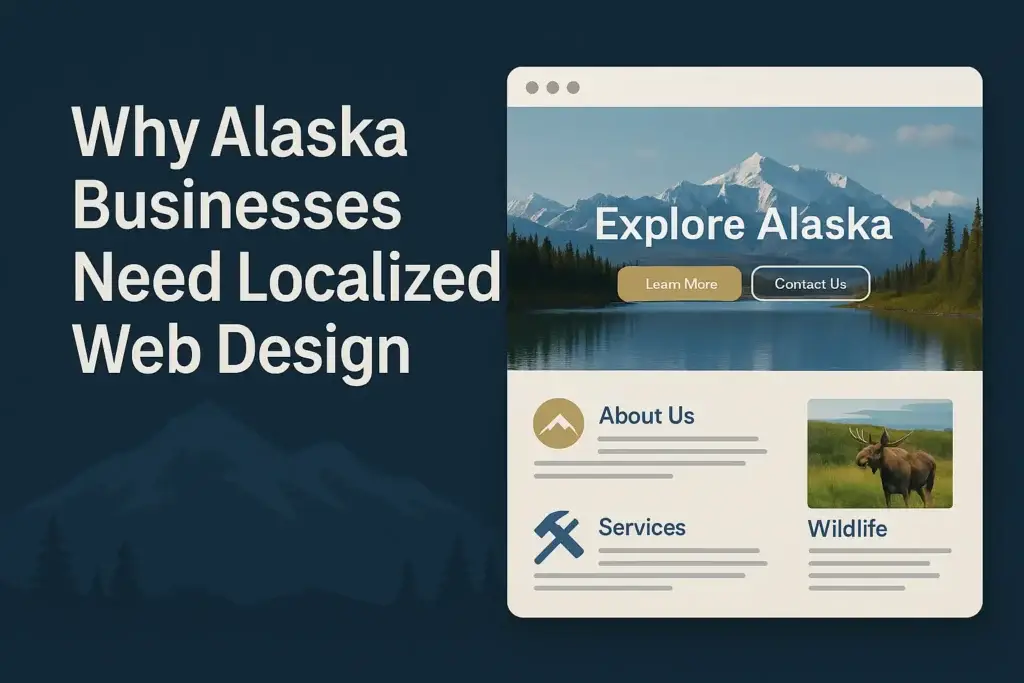
Design that Reflects Alaska’s Unique Market
Alaska isn’t just a location—it’s a lifestyle. From icy fjords and dense forests to self-reliant communities and indigenous heritage, the state is rich in personality. That’s why Alaska web design needs to go far beyond generic templates. Your website should reflect the unique soul of Alaska—visually, emotionally, and culturally.
Visuals Rooted in the Alaskan Experience
Stock photos of office desks and downtown skylines won’t resonate with an Alaskan audience. Instead, great web design for Alaska-based businesses draws inspiration from:
- Nature and landscape imagery (mountains, tundra, auroras)
- Local wildlife themes (moose, bears, eagles)
- Seasonal color palettes (cool blues, evergreen tones, warm wood hues)
These design elements instantly tell your visitor: “This is for you. This is Alaska.”
Whether you’re a fishing tour company in Seward or a coffee shop in Kodiak, your site’s aesthetic should reflect your environment.
Brand Tone That Feels Authentic
Alaskans value grit, independence, and realness. Your brand’s voice should speak to that. Web copy and messaging should avoid corporate fluff and instead be:
- Straightforward and honest
- Conversational and warm
- Reflective of the community you serve
For example, a simple tagline like “Built for the Last Frontier” connects much deeper than buzzwords like “cutting-edge” or “synergy.”
Culturally Aware Content
In many Alaskan communities, cultural heritage plays a central role. That includes indigenous values, local crafts, and traditions. Alaska web design should be careful to:
- Avoid cultural appropriation
- Celebrate diversity respectfully
- Feature local stories, artisans, and voices when possible
This not only builds trust—it makes your website more meaningful to your audience.
Local Testimonials and Real People
Instead of using placeholder avatars or anonymous reviews, Alaska businesses benefit from showcasing:
- Photos of real customers or team members
- Testimonials with names, locations, and specific experiences
- Behind-the-scenes visuals of life and work in Alaska
This kind of authenticity builds emotional connection, which is critical in remote and tight-knit markets.
Tailoring the User Journey to Local Habits
Don’t forget how people in Alaska actually use websites. Think about:
- Longer scroll pages (limited page refresh due to connection speed)
- Highlighting opening hours that reflect seasonal changes
- Promoting in-person pickup or local delivery in rural areas
Small details like these elevate the user experience and make your website feel custom—not canned.
In the next section, we’ll dive into why first impressions matter more in Alaska, and how your website can instantly build trust—or lose it—with just a few clicks.
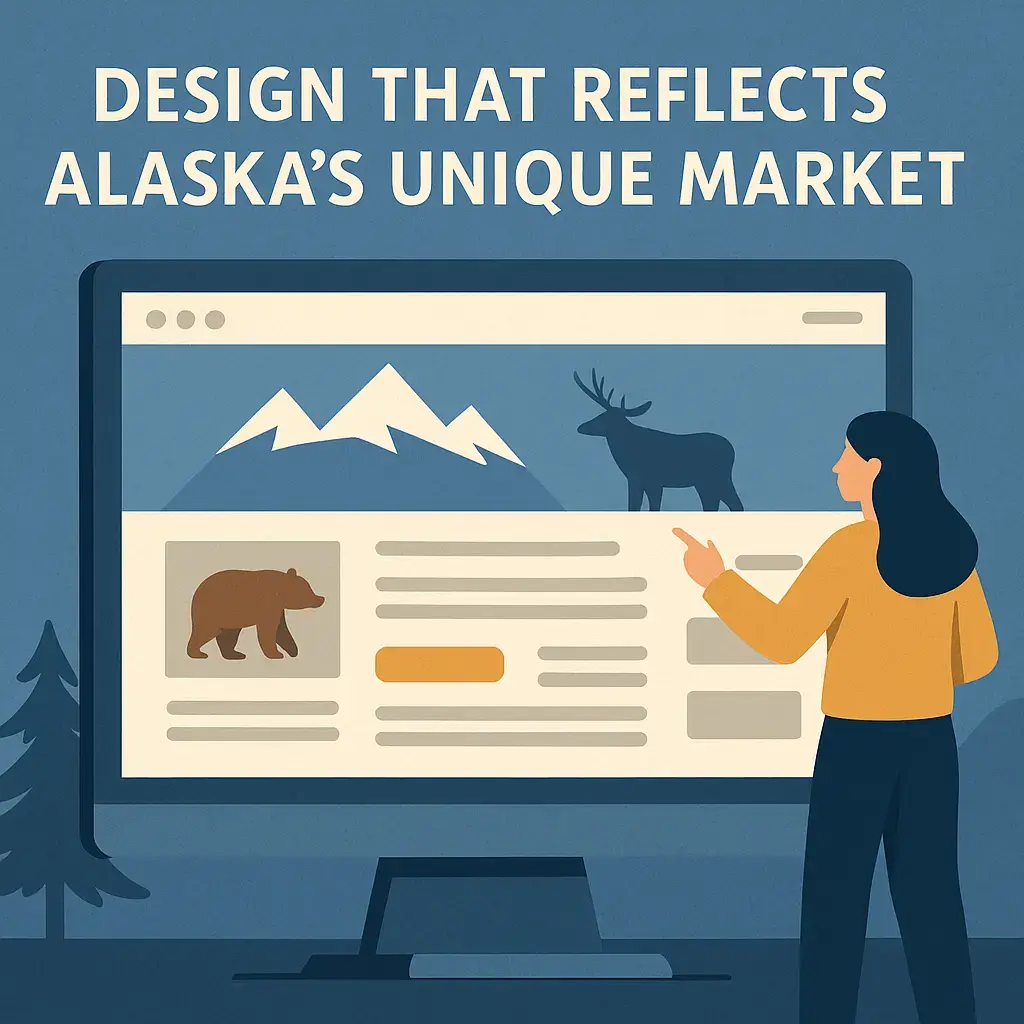
First Impressions: Earning Trust Instantly Online
You never get a second chance to make a first impression—especially online. In the fast-paced world of digital browsing, users form opinions about your website in seconds. That’s why Alaska web design isn’t just about aesthetics—it’s about trust, authority, and instant clarity.
Your Homepage = Your Handshake
In a traditional setting, you’d smile, shake hands, and start a conversation. But online, your homepage is doing all the talking. A cluttered, outdated, or confusing layout can immediately create doubt:
- “Is this business real?”
- “Do they know what they’re doing?”
- “Can I trust them with my money?”
Alaska web designers know this and build sites that immediately establish credibility, particularly in tight-knit, word-of-mouth-driven markets.
Visual Trust Cues That Work
There are specific visual elements that subconsciously trigger trust in your site visitors. These include:
- A clean, professional design with logical layout
- High-quality images (preferably local and authentic)
- Clearly displayed contact info (address, phone number, email)
- Trust badges like “Google Reviews,” SSL locks, affiliations
These design choices help bridge the gap between offline reputation and online experience—which is especially important for Alaska businesses with a strong local presence.
Branding for Trust
Strong branding is more than just a logo. It’s the consistency of colors, fonts, voice, and layout that sends a signal: “We are professional, and we’re here to stay.”
In Alaska web design, branding should:
- Reflect local identity without overdoing clichés
- Be visually cohesive across all pages
- Build confidence through storytelling and design harmony
When users feel like they know your business from the first scroll, they’re more likely to stay, explore, and eventually convert.
Clear Navigation & Calls-to-Action
Confusion kills trust. Alaska users—especially in rural or older demographics—appreciate simplicity and clarity. That means:
- Obvious menus with limited choices
- Calls-to-action like “Book Now” or “Call Us Today” that are visible and purposeful
- Easy access to business info, hours, services, and pricing
Even something as simple as a sticky phone number button on mobile can increase calls and build confidence.
Loading Speed & Mobile Experience
In regions where internet access can vary, site speed directly impacts trust. Slow sites feel broken, and broken = untrustworthy. That’s why Alaska web design focuses on:
- Speed-optimized assets
- Minimalistic, purposeful visuals
- Seamless mobile responsiveness
A fast, responsive, and visually trustworthy site builds belief—fast.
In the next section, we’ll dive into how Alaska web design and local SEO strategies work together to make sure your site isn’t just beautiful—but findable.
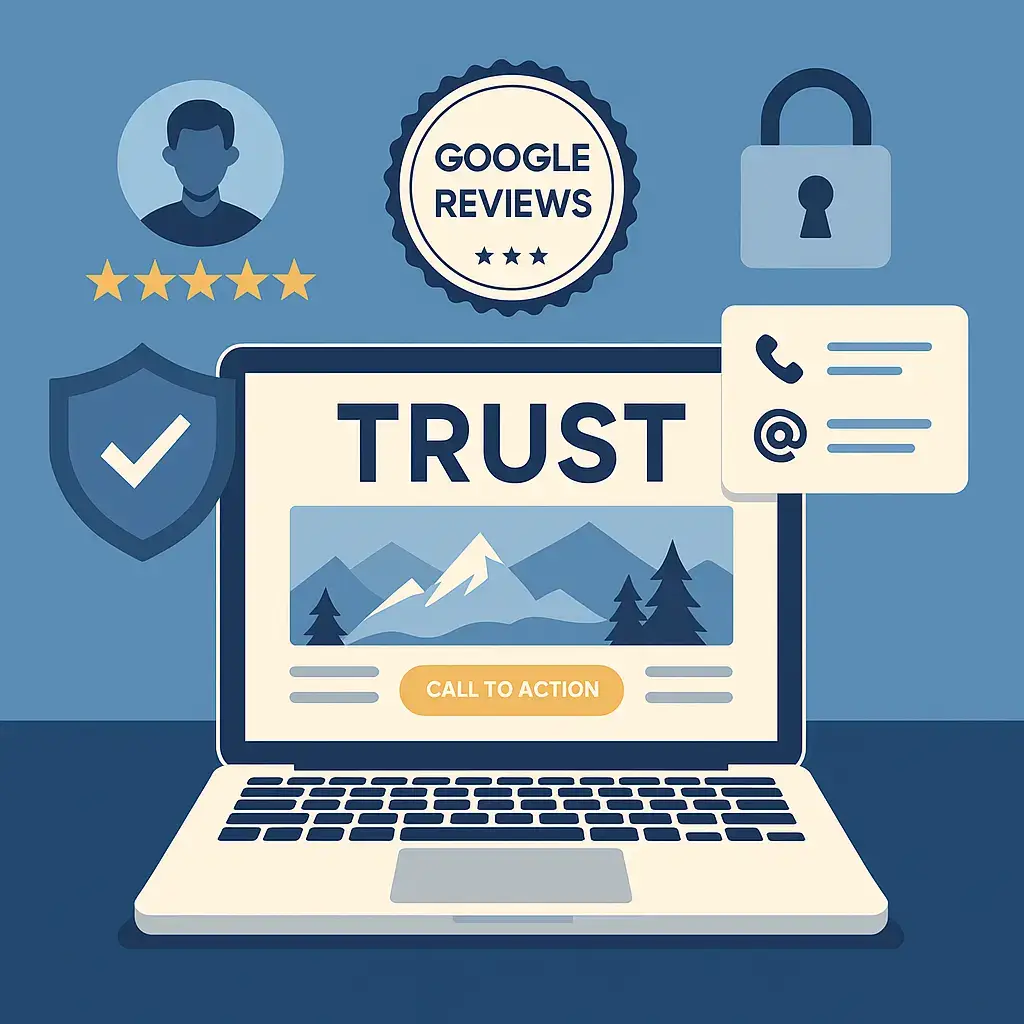
How Alaska Web Design Improves SEO and Visibility
Even the most beautiful website won’t help your business grow if no one can find it. That’s why SEO (Search Engine Optimization) is a key component of effective Alaska web design. When built correctly, your website becomes a powerful magnet—pulling in traffic from Google, Bing, and beyond.
It Starts with Site Structure
Great SEO begins at the foundation: the structure of your site. Local Alaska web designers who understand SEO will:
- Use clean URL structures like
/services/web-design-juneau - Optimize headings (H1, H2, H3) for readability and search clarity
- Include internal links that guide users and help Google understand site hierarchy
- Provide image alt text that describes visuals with relevant keywords
A well-structured website helps search engines crawl and index your pages effectively, leading to higher rankings.
Geo-Targeted Keywords That Drive Local Traffic
When someone in Alaska searches for “web design Anchorage” or “SEO expert Fairbanks,” your site should show up. That’s only possible with:
- Geo-specific keyword targeting
- City-based landing pages (e.g., “Web Design in Wasilla”)
- Locally written content that reflects regional needs
Effective Alaska web design incorporates these elements seamlessly into the layout and content.
Mobile Optimization Is Essential
In Alaska, many users rely on mobile devices—especially in remote areas. That means your site needs to be:
- Fully responsive
- Fast-loading on mobile networks
- Easy to navigate with thumbs (no tiny menus or hidden buttons)
Google uses mobile-first indexing, meaning your mobile site is what determines your search ranking. If your mobile design fails, your visibility suffers.
Speed Optimization for Remote Users
Alaska’s internet infrastructure can be spotty, particularly in rural areas. That’s why Alaska web design teams focus on:
- Compressing images and assets
- Using lightweight themes and code
- Implementing caching strategies
- Minimizing external scripts
A fast website keeps visitors engaged—and signals to Google that your site provides a great user experience, which boosts rankings.
Content Built for Humans and Search Engines
Great SEO content is both informative for users and optimized for algorithms. Alaska designers often work hand-in-hand with content creators to ensure:
- Keyword-rich headlines and meta descriptions
- FAQ sections that answer real user questions
- Blog posts that target seasonal or regional search trends
This creates long-term SEO value and makes your site a trusted resource in your niche.
In the next section, we’ll compare working with local Alaska agencies vs. freelancers—and how to choose the best web design partner for your business.
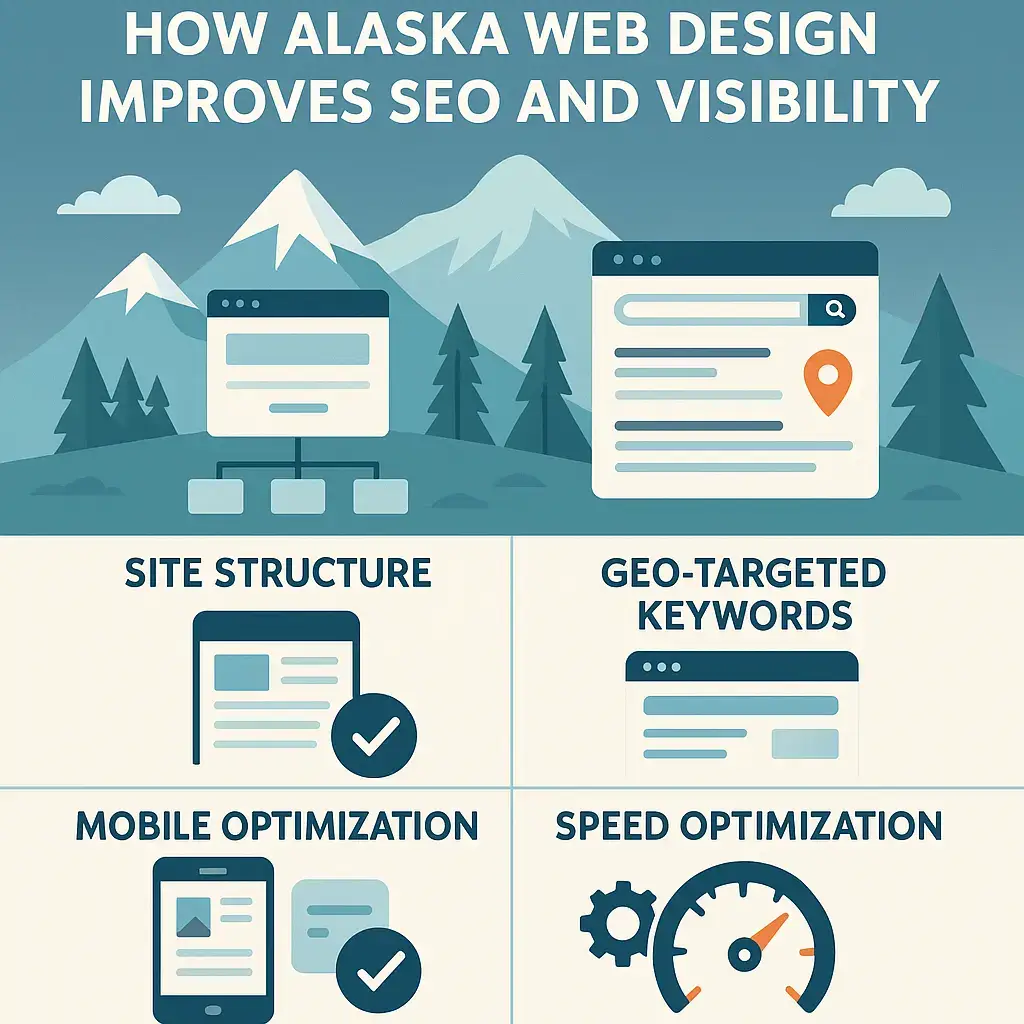
Choosing Between Local Agencies and Freelancers in Alaska
Once you’ve decided to invest in Alaska web design, the next big decision is: who will build your website? In most cases, you’re choosing between a local design agency and a freelance professional. Each option offers unique benefits depending on your goals, budget, and timeline.
Let’s break down the differences.
The Benefits of Working with a Local Web Design Agency
Web design agencies in Alaska often provide full-service solutions, including:
- Web design and development
- SEO and digital marketing
- Copywriting, branding, and photography
- Ongoing maintenance and support
Pros of agencies:
- A team of specialists under one roof
- Project management and defined processes
- Access to more tools and scalable infrastructure
- Reliable for long-term partnerships
Agencies are ideal for businesses that:
- Need a comprehensive digital presence
- Plan to scale quickly
- Want to invest in branding and SEO long-term
A great example?
👉 Curtis Design – an experienced agency delivering high-performance websites tailored to both local and national markets.
Why Choose a Freelance Web Designer?
Freelancers are independent professionals who typically handle the entire project themselves. Alaska has many talented freelancers who offer:
- Affordable pricing
- Direct communication
- Flexible timelines
- Personalized attention
Pros of freelancers:
- Lower overall cost
- Faster response times
- Ideal for small, brochure-style websites
Freelancers are great for:
- Startups and side projects
- One-page websites or portfolios
- Businesses with tight budgets
However, keep in mind:
- Freelancers may lack specialized skills (e.g., SEO or security)
- You’re reliant on one person’s availability and experience
- Long-term support may not be guaranteed
Questions to Ask Before Choosing Either Option
Regardless of your choice, be sure to ask:
- What’s included in the price?
- Can I see a portfolio of Alaska-based work?
- How do you handle revisions and communication?
- Do you provide post-launch support?
The answers will help you make an informed, confident decision.
It’s Not Just About Budget—It’s About Fit
Don’t just choose based on price. Think about:
- Your business stage
- Your technical comfort level
- How much time you can dedicate to the process
Sometimes a freelancer is perfect. Other times, the structure and team of an agency are essential. The good news? Alaska offers both—so you’re never short on great options.
Next: I’ll write a strong conclusion and provide 6 FAQs to wrap up the article.
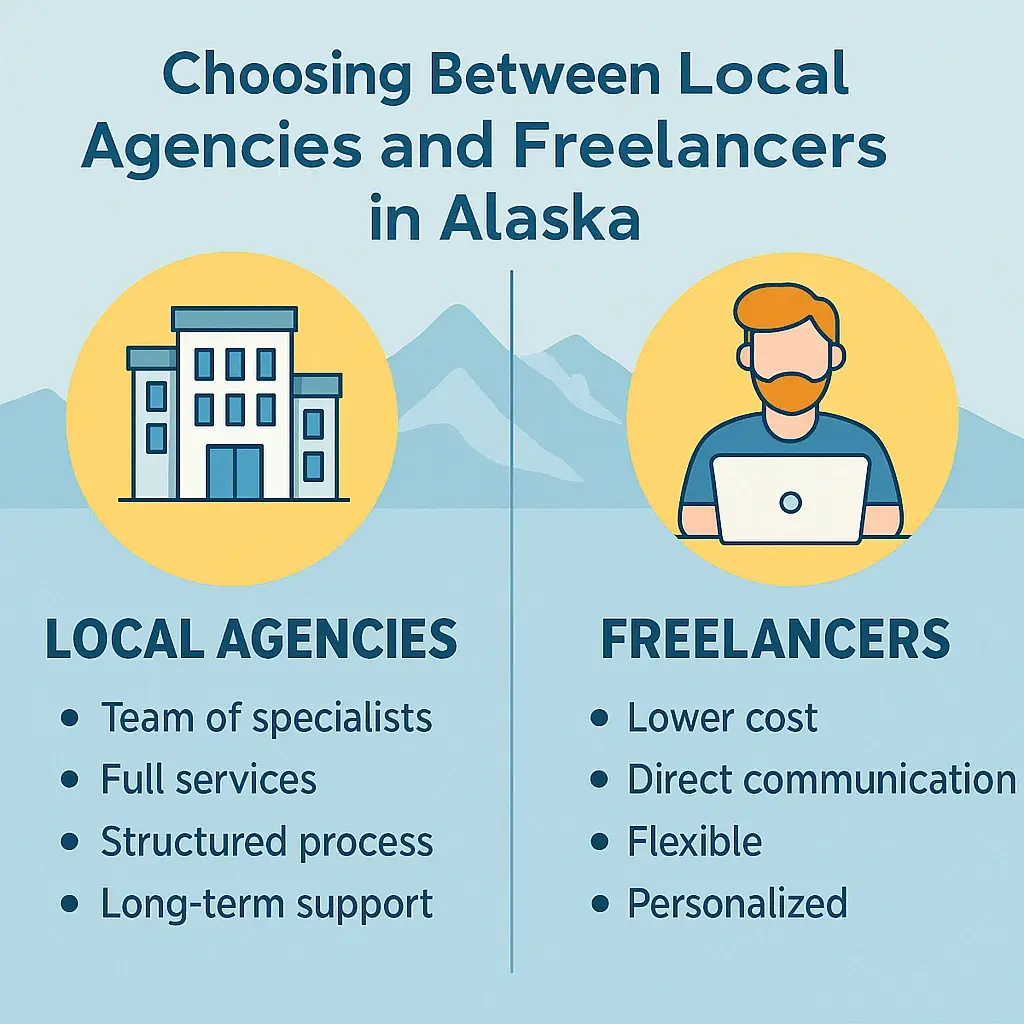
Why Alaska Web Design Is a Strategic Investment
In today’s digital-first world, your website is more than just an online business card—it’s the foundation of your brand. And when you operate in a place as unique as Alaska, your site needs to reflect that. From regional aesthetics and local SEO to trust-building design and reliable mobile performance, Alaska web design offers targeted solutions for small and mid-sized businesses ready to grow.
Whether you’re choosing a freelancer for a one-page site or partnering with a full-service agency like Curtis Design, investing in a professionally built website is a long-term decision that will pay off with more visibility, trust, and conversions.
Alaska may be remote—but your business presence doesn’t have to be.
❓ Frequently Asked Questions (FAQs)
Why is Alaska web design different from other states?
Because Alaska’s geography, culture, and consumer behavior are unique, design strategies here prioritize trust, clarity, and speed for users in both rural and urban communities.
Should I work with a freelancer or an agency?
It depends on your needs. Freelancers are great for small, affordable projects, while agencies provide structured support for larger websites and SEO campaigns. For full-service support, Curtis Design is a reliable option.
What industries benefit most from Alaska web design?
Tourism, outdoor adventure, healthcare, local services, retail, and logistics companies benefit the most—especially those looking to grow their online presence and reach new local customers.
How long does it take to build a website in Alaska?
Simple websites can take 2–4 weeks. Larger, more customized projects may take 6–10 weeks depending on revisions, content readiness, and technical scope.
Do I need SEO with my web design?
Absolutely. Without SEO, your beautiful site won’t be found. Make sure your Alaska web design partner includes SEO best practices or works with an SEO expert.
Can my existing website be updated for Alaska audiences?
Yes! Many businesses choose to redesign or localize their existing websites to better resonate with Alaskan audiences—through visuals, content, and SEO targeting.
